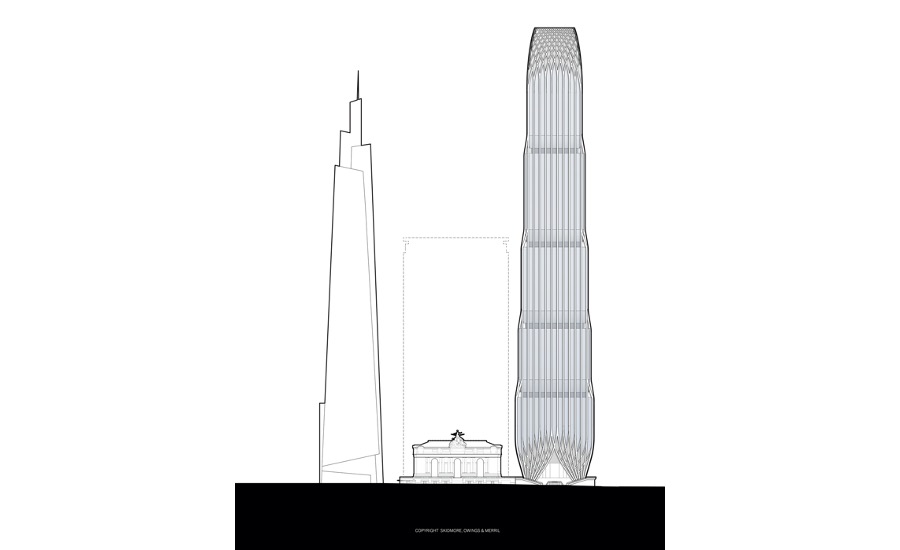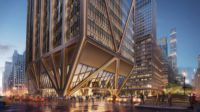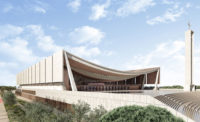In 1980, Donald Trump made his first foray in Manhattan real estate, turning the stolid 26-story Commodore Hotel on Manhattan’s East 42nd Street into the ugly, glass-encased Grand Hyatt. That same year, architect T.J. Gottesdiener went to work at Skidmore, Owings & Merrill.
Forty years later, the hotel has outlived its usefulness, and Gottesdiener, now a consulting partner at SOM, has designed a two-million-square-foot mixed use tower to replace it. The 1,653-foot-high building will be half again as tall as the Chrysler Building, immediately across Lexington Avenue, making the art deco masterpiece invisible from the west. But Jon McMillan, the director of planning for TF Cornerstone, co-developer of the building, argues that the Chrysler Building is already obscured by One Vanderbilt, the brand new 1,401-foot-high KPF tower just west of Grand Central Terminal, and that his much taller building, on the east side of the terminal, will at least provide a neutral backdrop for William Van Alen’s classic spire. (Renderings showing the relationship of the new building to its 1930 neighbor have not yet been released, though McMillan says “they’re coming.”) Meanwhile, views of Chrysler from the northeast will be erased by Foster + Partner’s new tower at 270 Park Avenue, expected to top out at more than 1,400 feet. McMillan says he believes the three supertalls will have a “lovely relationship” and that “a new Manhattan skyline is emerging."

Not everyone is happy about that new skyline, the result of Mayor Michael Bloomberg’s 2017 upzoning of the east Midtown neighborhood. “New York has two skyscrapers that are indispensable to the character of the city—the Empire State Building and the Chrysler Building—and to overwhelm one of them in this way is a sacrilege,” says Samuel White, a founding partner of the firm Platt Byard Dovell White (and a great-grandson of Stanford White). The new SOM building, White later wrote in an email, “replaces bad taste (Trump's mirrored curtain wall) with bad manners.”
TF Cornerstone and its development partner RXR, made the announcement when Manhattan office space is going begging. With an expected cost of about $3 billion, the building “is a vote of confidence in New York City’s future,” McMillan says, though he concedes that construction won’t begin until an anchor tenant emerges. “Of course it scares you,” he says of the pandemic, “but we think things will get back to normal. There will always be top companies looking for office space and don’t want to go all the way down to the World Trade Center.” The building, to be known as 175 Park Avenue, hasn’t been redesigned in light of the coronavirus, but state-of-the-art air handling systems and column-free floor plates of varying sizes, will give tenants safety and maximum flexibility, he says.
The building, which will take until 2030 to complete, has been in the planning stages for more than three years, according to McMillan. Early steps included negotiating with the Metropolitan Transit Authority about the project’s impact on the subway station directly below it. The developers will greatly expand the station and add significant new public spaces, including a plaza, by James Corner Field Operations, that will wrap around the building. But the presence of the station means the new building can touch the ground only at two points on 42nd Street. At each of those points, a bundle of curved columns will emerge from the ground. (The two bundles, one observer noted, will make the building’s 42nd Street façade “look like a giant pair of harem pants.”) The columns will form a tube-like structural system at the building’s perimeter, similar to that of Minoru Yamasaki’s World Trade Center towers. The building will house a new Hyatt on its top floors, below what is expected to be the highest roof in the Western Hemisphere. (A few buildings with lower roofs are nominally higher, thanks to spires or antennas.)
Almost half a century ago, the U.S. Supreme Court upheld New York City’s landmarks preservation law in a case that barred building directly over Grand Central Terminal. Yet it is only because the developers bought Grand Central’s air rights that they now hope to reach almost a third of a mile into the sky. With the SOM building on one side and One Vanderbilt on the other, Grand Central may look as if it’s fallen to the bottom of a canyon.







Post a comment to this article
Report Abusive Comment